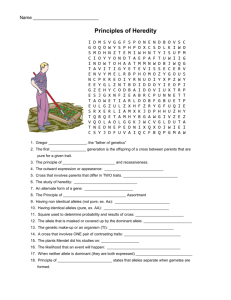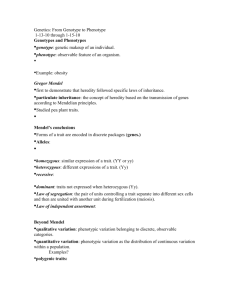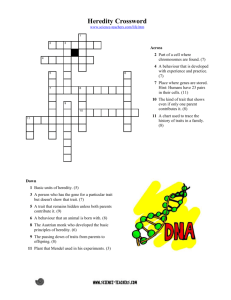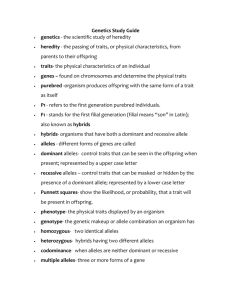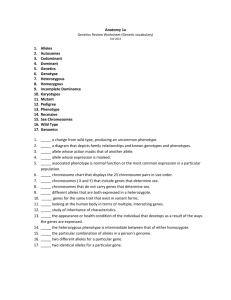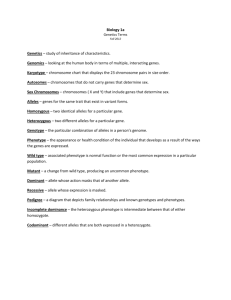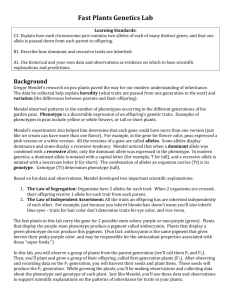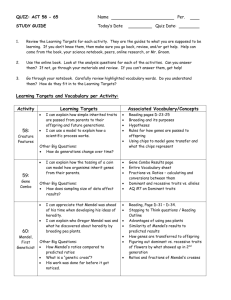Inherited Traits
advertisement
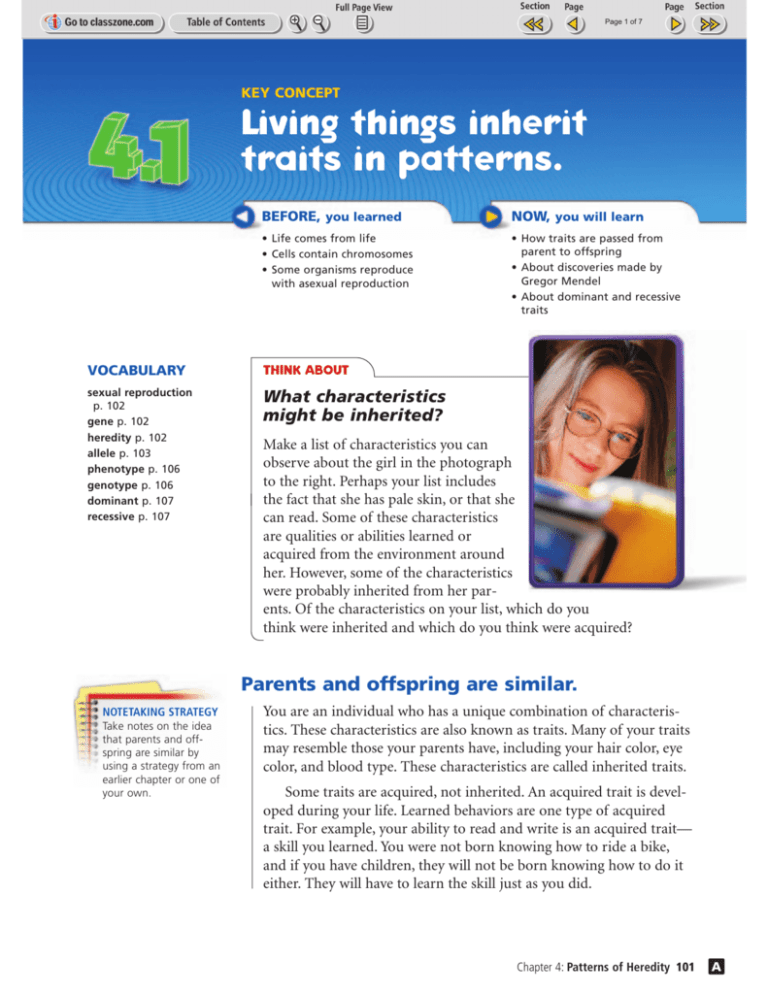
Page 1 of 7 KEY CONCEPT Living things inherit traits in patterns. BEFORE, you learned NOW, you will learn • Life comes from life • Cells contain chromosomes • Some organisms reproduce with asexual reproduction • How traits are passed from parent to offspring • About discoveries made by Gregor Mendel • About dominant and recessive traits VOCABULARY \THINK ABOUT sexual reproduction p. 102 gene p. 102 heredity p. 102 allele p. 103 phenotype p. 106 genotype p. 106 dominant p. 107 recessive p. 107 What characteristics might be inherited? Make a list of characteristics you can observe about the girl in the photograph to the right. Perhaps your list includes the fact that she has pale skin, or that she can read. Some of these characteristics are qualities or abilities learned or acquired from the environment around her. However, some of the characteristics were probably inherited from her parents. Of the characteristics on your list, which do you think were inherited and which do you think were acquired? Parents and offspring are similar. NOTETAKING STRATEGY Take notes on the idea that parents and offspring are similar by using a strategy from an earlier chapter or one of your own. You are an individual who has a unique combination of characteristics. These characteristics are also known as traits. Many of your traits may resemble those your parents have, including your hair color, eye color, and blood type. These characteristics are called inherited traits. Some traits are acquired, not inherited. An acquired trait is developed during your life. Learned behaviors are one type of acquired trait. For example, your ability to read and write is an acquired trait— a skill you learned. You were not born knowing how to ride a bike, and if you have children, they will not be born knowing how to do it either. They will have to learn the skill just as you did. Chapter 4: Patterns of Heredity 101 A E Page 2 of 7 Some acquired traits are not learned but result from interaction with the environment. Skin color, for example, has both an inherited component and an environmental one. The skin color of many lightskinned people darkens when they are exposed to the Sun. Check Your Reading How are inherited traits and acquired traits different? Give one example of each. In this chapter, you will learn about inheritance that happens through sexual reproduction. During sexual reproduction a cell containing genetic information from the mother and a cell containing genetic information from the father combine into a completely new cell, which becomes the offspring. You will learn more about the mechanics of sexual reproduction in Section 4.3. RESOURCE CENTER CLASSZONE.COM Find out more about sexual reproduction. Genes are on chromosome pairs. Inherited traits are controlled by the structures, materials, and processes you learned about in Chapters 1 and 2. In turn, these structures, materials, and processes are coded for by genes. A gene is a unit of heredity that occupies a specific location on a chromosome and codes for a particular product. Heredity is the passing of genes from parents to offspring. Individuals inherit their genes from their parents. The genes code for the expression of traits. It is important to understand that an organism does not inherit the traits themselves from its parents. It inherits Chromosomes and Genes the genes that code for the traits it has. The letters on the pair of chromosomes Most traits are not coded for by just one below represent alleles. gene. Some characteristics are affected by many genes in complicated ways. We Chromosomes come in pairs called homologs. have much to learn about which genes might affect which characteristics. A gene occupies a specific location on both chromosomes in a pair. A E A a B B c C d d E e F F g G h H 102 Unit: Cells and Heredity Alleles, which come in pairs, are alternate forms of the same gene. Cells contain pairs of chromosomes, with one chromosome of each pair coming from each of two parents. The chromosomes in a pair are called homologs. They resemble each other, having the same size and shape, and carrying genetic information for particular traits. On each homolog are sites where specific genes are located. Let us say, for example, that the gene that determines Page 3 of 7 whether or not a plant is tall is located at place A on a pair of homologs. Though both homologs have the gene for height at site A, the genes may not be identical. They may be variations instead. The various forms of the same gene are called alleles (uh-LEELZ). Thus, the homolog from one parent might have an allele for regular height at site A, while the gene from the other parent might have an allele for short height at site A. The alleles on a pair of homologs may or may not be different. Though any one plant can have only two alleles of a gene, there can be many alleles for a particular gene within a population. Check Your Reading reading tip The word homolog comes from the Greek words homos, which means "same," and logos, which means "proportion.” What are alleles? Each species has a characteristic number of chromosomes. Chimpanzees have 24 pairs of chromosomes, for a total of 48 chromosomes. Fruit flies have 4 pairs of chromosomes, or 8 in all. Humans have 23 pairs, for a total of 46 chromosomes. Scientists refer to chromosomes by their number. Human chromosomes are numbered 1 through 22; the 23rd pair are the sex chromosomes. In humans, the sex chromosomes are called the X-chromosome and the Y-chromosome. A human female has two X-chromosomes, while a human male has one X-chromosome and one Y-chromosome. In addition to determining the sex of an offspring, the X- and Y-chromosomes contain important genes, just as the other, numbered chromosomes do. Human Chromosomes Humans have 23 pairs of chromosomes, for a total of 46. One of these pairs, shown below, determines the sex of a human offspring. X-chromosome Y-chromosome An offspring with XY, as shown, is male. Female offspring have two X-chromosomes. Chapter 4: Patterns of Heredity 103 A E Page 4 of 7 Gregor Mendel made some important discoveries about heredity. The first major experiments investigating heredity were performed by a monk named Gregor Mendel, who lived in Austria during the mid1800s. Before Mendel became a monk, he attended university and received training in science and mathematics. This training served him well when he began investigating the inheritance of traits among the pea plants in the monastery’s garden. reading tip The root of the word trait means to “draw out.” It was originally used in the sense of drawing out a line. This same idea works in heredity if you link of drawing a connection between parents and offspring. Mendel took very detailed notes, carefully recording all the data from his many experiments. He worked with seven different traits: plant height, flower and pod position, seed shape, seed color, pod shape, pod color, and flower color. He studied each trait separately, always starting with plants that were true-breeding for that one particular trait. A true-breeding plant is one that will always produce offspring with a particular trait when allowed to self-pollinate. One Example In his experiments with plant height, Mendel took two sets of plants, one true-breeding for plants of regular height and the other truebreeding for plants of short or dwarf height. 1 Instead of letting the plants self-pollinate as they do naturally, he deliberately paired as parents one plant from each set. Mendel called the plants that resulted from this cross the first generation. All of the plants from this first generation were of regular height. The dwarf-height trait seemed to have disappeared entirely. 2 Mendel then let the first-generation plants self-pollinate. He called the offspring that resulted from this self-pollination the second generation. About three fourths of the second-generation plants were of regular height, but about one fourth were of dwarf height. So the trait that seemed to disappear in the first generation reappeared in the second generation. Mendel’s experiments with other traits showed similar patterns. Check Your Reading Summarize the pattern shown in Mendel’s experiments with plant height. Mendel’s Conclusions Mendel drew upon his knowledge of mathematics while analyzing his data in order to suggest a hypothesis that would explain the patterns he observed. Mendel realized that each plant must have two “factors” for each possible trait, one factor from each parent. Some traits, such as dwarf height, could be masked—dwarf height could be seen in the A E 104 Unit: Cells and Heredity Page 5 of 7 Mendel’s Pea Plants Mendel observed variation in the height of pea plants (regular or dwarf height). By crossing plants with specific traits, he deduced that offspring get factors for each trait from both parents. Parent Plants X regular 1 First generation Crossing a true-breeding regular pea plant with a true-breeding dwarf pea plant produces all regular pea plants in the first generation. X regular 2 dwarf regular regular regular Second generation Allowing the first generation pea plants to self-pollinate resulted in about three-fourths regular pea plants and one- fourth dwarf pea plants. regular regular regular dwarf plant only if both of the plant’s factors were for dwarf height. All of the plants in the first generation had one dwarf factor and one regular factor. A plant with one dwarf-height factor and one regular-height factor would be of regular height, because the regular-height factor masks the dwarf-height factor. Later experiments allowed Mendel to draw a number of other conclusions about how these factors are distributed. Since the mid-1800s, Mendel’s experiments and conclusions have been the basis for most of the scientific thought about heredity. Those things he called “factors” are what we now call genes and alleles. Check Your Reading How many factors or genes does each plant have for each possible trait? Chapter 4: Patterns of Heredity 105 A E Page 6 of 7 Alleles interact to produce traits. The pea-plant traits Gregor Mendel chose to study were all controlled by single genes, and each of the genes was on a different chromosome. As you learned earlier, most traits are not controlled by only one gene. However, simple examples such as Mendel’s peas do help us better understand heredity. reading tip The word phenotype and phenomenon have a similar root word meaning “to appear.” VOCABULARY Make word magnet diagrams for the terms phenotype and genotype. Phenotype and Genotype What color eyes do you have? The eye color you see when you look in the mirror is your phenotype. An organism’s phenotype describes the actual characteristics that can be observed. Your height, the size of your feet, the presence or absence of a fold in your eyelids—all are observable traits and are part of your phenotype. By contrast, the genes that control the development of eyefolds are part of your genotype. Genotype is the name for the genes an organism has. Your genotype is not always obvious from your phenotype. If you have eyefolds, your genotype definitely contains at least one eyefold-producing allele. But it may also have one allele for no eyefolds. Sometimes your genes contain information that is not expressed in your phenotype. Check Your Reading Is eye color a phenotype or a genotype? How do you know? eye with folds at the corner of the eyelids eye without folds at the corner of the eyelids COMPARE The photograph above shows phenotypes of the eyefold gene. A person with eyefolds is shown to the left, a person without eyefolds to the right. A E 106 Unit: Cells and Heredity Page 7 of 7 Dominant and Recessive Alleles The eyefold gene, which controls development folds in the eyelids, comes in two alleles: eyefolds and no-eyefolds. If you have even one copy of the allele for eyefolds, you will have eyefolds. This happens because the allele for producing eyefolds is dominant. A dominant allele is one that is expressed in the phenotype even if only one copy is present in the genotype—that is, even if the other allele is an alternative form. Suppose your genotype contains a no-eyefolds allele. The noeyefolds allele is recessive. A recessive allele is one that is expressed in the phenotype only when two copies of it are present on the homologs. If one chromosome in the pair contains a dominant allele and the other contains a recessive allele, the dominant phenotype will appear. If you do not have eyefolds, it is because you got two no-eyefolds genes—one from each parent. Check Your Reading Under what conditions is a recessive allele expressed in an offspring’s phenotype? The interaction of dominant and recessive alleles means that it is possible for two brownhaired parents to have a blond child. Hair color is determined by multiple genes, can be affected by the environment, and sometimes changes over time. However, in some cases it has a dominantrecessive pattern similar to that of the eyefold gene. As in the family shown at right, parents who both have brown hair can have a blond child. Brown hair is dominant, so if both parents have alleles for both brown hair and blond hair, the brown-hair allele is more likely to be expressed. Their child, however, could have two blond-hair alleles (one from each parent) and therefore have blond hair instead of brown. KEY CONCEPTS CRITICAL THINKING 1. Explain the difference between acquired and inherited traits. 4. Compare and Contrast What is the difference between a genotype and a phenotype? 2. Describe the conclusions that Mendel drew from his experiments with pea plants. 3. What type of alleles a.e expressed only if an identical pair exist on the chromosome of the offspring? 5. Analyze Explain why a person with an allele for a particular trait may not have a phenotype that shows the trait. CHALLENGE 6. Apply In guinea pigs, the allele for black fur is dominant over the allele for brown fur. If you had two parent guinea pigs, each with brown fur, what color fur might the offspring have, and why? Chapter 4: Patterns of Heredity 107 A E

